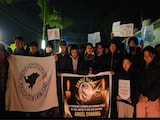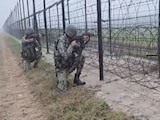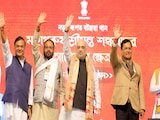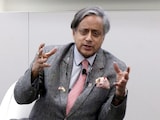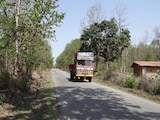Oblivious of Congress's history and the part played by it in the Ram Janmabhoomi movement, both obtrusively and unobtrusively, the current leadership of the Grand Old Party has withdrawn into a self-glorifying cocoon and has decided to stay away from the Pran Pratishtha ceremony in Ayodhya on Monday January 22.
Calling it "Modi's function", Rahul Gandhi has put estoppels on the party. On January 15, a motley group of Congress leaders took a dip in the river Sarayu in Ayodhya to mark Makar Sankranti. Ram ki Paidi, the series of ghats where the event took place, was refurbished to its present glory by the Congress regime of Sripati Misra in 1983 after floods devastated Ayodhya. The then irrigation minister, Virbahadur Singh (who later became chief minister of Uttar Pradesh), played a yeoman role.
Since taking office, Yogi Adityanath, who, like Virbahadur, is from Gorakhpur, has used the Ram ki Paidi to enter the Guinness Book of records by lighting five lakh lamps on Diwali on its majestic ghats (the spectacle will be bettered on January 22). The Congress leaders taking the ritualistic bath on Makar Sankranti were perhaps unaware of the role their party had played in providing this facility in Ayodhya, which is emerging as the 'Hindu Vatican'.
INDIA alliance parties have echoed Rahul Gandhi's sentiment and said they will not be seen in Ayodhya on January 22. All, however, have created alibis. Mamata Banerjee has said she will pray at Kalighat temple and lead a "Harmony rally' in Kolkata. Uddhav Thackrey is headed for Kalaram Temple in Nashik, from where Narendra Modi last week began his 11-day choreography of faith, of observing yam-niyam fasting and rituals to prepare himself for the Ayodhya ceremony. Sharad Pawar, Akhilesh Yadav, Lalu Yadav and Arvind Kejriwal have said they will visit Ayodhya on a later date. Kejriwal has started mass recitation of the Hanuman Chalisa in Delhi, organised by Aam Aadmi Party (AAP) units.
Preceding the mega event in Ayodhya, Odisha's Naveen Patnaik, who retains equidistance from all camps, has inaugurated a grand parikrama of the Jagannath temple at Puri. The revamp of temples is not confined to Puri alone. In Kolkata, the Kalighat temple is being refurbished. Vindhyavasini temple in Uttar Pradesh's Mirzapur area is undergoing beautification. The Kashi Vishwanath corridor in Varanasi and the ornamentalisation of Mahakal in Ujjain preceded these endeavours. Karnataka is planning a temple at Hampi, which is said to be Kishkindha, the legendary birthplace of Hanuman.
The Congress is ambivalent about what it plans to do on a day slated to be modern India's national carnival. (Speculation is that Rahul may visit the Kamakhya shrine in Guwahati.) After invites for the Pranpratishta ceremony were sent to Sonia Gandhi, Mallikarjun Kharge and Adhir Ranjan Chowdhury, the party dithered for a fortnight before Jairam Ramesh announced that the three will stay away. The party's penchant for differing was marked by its usual dithering.
The murmur of dissent shrouds Congresspersons. Arjun Modhvadia, the party's MLA from Mahatma Gandhi's birthplace Porbandar, and Nirmal Khatri, ex-MLA from Faizabad (now Ayodhya), have differed and sought course correction. Modhvadia and Khatri headed the Congress units in Gujarat and UP in the past. Himachal's Congress Chief Minister Sukhvinder Sukhu, who had defied his party's diktat and attended PM Modi's G20 dinner, declared on January 9 his intention to be in Ayodhya. His ministerial colleague, Vikramaditya Singh too has expressed his desire to be in Ayodhya "out of respect" for his late father "who was involved in the Ram Jannmabhoomi movement". (His father, Virbhadra Singh, ex-Chief Minister was a Congress stalwart.)
Had assassin Beant Singh not silenced Indira Gandhi on 31 October 1984, the history of the Ram Janmabhoomi movement may have had a chapter, which was nixed by bullets. The next day, the Prime Minister was scheduled to receive a delegation of the Vishwa Hindu Parishad (VHP) to hear them on the Ayodhya issue.
The VHP's Ram-Janaki Yatra, starting from Sita's birthplace Sitamarhi in Bihar, had travelled through Ayodhya and reached Delhi to highlight the Ram Janmabhoomi issue. Uttar Pradesh's Congress Chief Minister Narayan Dutt Tiwari provided the VHP logistical support by assigning a medical team for the yatris. A memorandum was to be received by Indira Gandhi on November 1.
The Yatra followed the decision of the VHP's first "Dharma Sansad", held earlier that year to consolidate Hindu preachers under an umbrella organisation. The meet was held in Delhi's Vigyan Bhavan. A year before, it had been the venue of the Non-Aligned Meet, the Indira Gandhi-era equivalent of Narendra Modi's G20 triumph. Booking Vigyan Bhavan requires the government's consent.
In 1981, the conversion of some 1,100 Dalits into Islam at Meenakshipuram in Tamil Nadu's Tirunelveli district raised a windstorm. Speaking in parliament, then Home Minister Gyani Zail Singh said conversions were "a conspiracy of political motivation". Indira Gandhi was said to be unhappy. (All 1,100 returned to the Hindu fold after 'shuddhikaran' by VHP.)
The VHP, founded in 1964, had been somewhat dormant at the time. Meenakshipuram triggered its reactivation. Covert consultations ensued between the powers that be and then Rashtriya Swayamsevak Sangh (RSS) Sarsanghchalak, Balasaheb Deoras (whose brother Bhaurao, a leading RSS ideologue, acted as conduit). The RSS and Congress had engaged in low-key dialogue since the Sanjay Gandhi days. They reached a crescendo in the Rajiv Gandhi era.
Meenakshipuram saw the creation of the Virat Hindu Parishad under Congress leader and Vedic scholar Dr Karan Singh. The group had taken out a nationwide Ekatmata Yatra. Dr Singh, now 92, has criticised his party's January 22, 2024 stance.
The BJP was launched in April 1982 by former Jan Sangh members who broke away from the Janata Party (into which the 1951-founded Jana Sangh had merged in 1977). The nascent party won only two Lok Sabha seats in the post-Indira Gandhi polls of December 1984. Meenakshipuram and later Ram Janmabhoomi emerged as the BJP's clarion call over the coming years.
In 1989, the Congress dwindled from 404 to 197 while the BJP increased its strength 43 times to reach 87 till then the highest tally of a Sangh outfit ever. In the years that followed, the Congress shrank and the BJP, bolstered by its Ram Janmabhoomi stand, grew from strength to strength.
The 1986 decision of the Rajiv Gandhi government to reverse the Supreme Court judgment in the Shah Bano case, under pressure from conservative Muslims, was seen as a move in which the Sharia law was given precedence over the Constitution of India. This sharpened the Ayodhya demand. The BJP added Ayodhya to its core agenda through the Palampur resolution in 1989.
In order to balance the feelings of both Muslims and Hindus, the Congress leadership agreed to open the lock at the Ram Janmabhoomi site in Ayodhya (the keys could not be found; the locks were broken open by the government under a magistrate's order). In the run-up to the 1989 elections, the Rajiv Gandhi government allowed the shilanyas (foundation stone laying) of the temple and Rajiv Gandhi began the 1989 Lok Sabha campaign at Ayodhya with the promise of "Ram Rajya". In 1991, the Congress promised a Ram Temple in its poll manifesto.
The telecast of Ramanand Sagar's Ramayan serial on Doordarshan (the only TV channel then) since 1987 had been initially opposed by Information and Broadcasting Minister HKL Bhagat. A letter from Balasaheb Deoras, which addressed the Prime Minister as "Cheeranjiv Rajiv" is believed to have clinched the issue. The Ramayan serial played a yeoman role in build up to the Ram Janmabhoomi fervour.
The banishment of the Congress as the dominant political party and the emergence of the BJP as the party of governance ensued post 1989. A headline in the Times of India on 10 November 2019, post the Supreme Court judgment that paved the way for the Ram temple, said: "Rajiv opened the lock; saffron got the key".
Ayodhya has been a saga of the Congress's tragedy of errors. Staying away from the Pran Pratishtha carnival will add yet another chapter to this epic.
(Shubhabrata Bhattacharya is a retired Editor and a public affairs commentator)
Disclaimer: These are the personal opinions of the author
